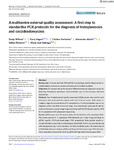2023-05-11Zeitschriftenartikel
A multicentre external quality assessment: A first step to standardise PCR protocols for the diagnosis of histoplasmosis and coccidioidomycosis
Wilmes, Dunja
Hagen, Ferry
Verissimo, Cristina
Alanio, Alexandre
Rickerts, Volker
Buitrago, Maria José
Background
In-house real-time PCR (qPCR) is increasingly used to diagnose the so-called endemic mycoses as commercial assays are not widely available.
Objectives
To compare the performance of different molecular diagnostic assays for detecting Histoplasma capsulatum and Coccidioides spp. in five European reference laboratories.
Methods
Two blinded external quality assessment (EQA) panels were sent to each laboratory that performed the analysis with their in-house assays. Both panels included a range of concentrations of H. capsulatum (n = 7) and Coccidioides spp. (n = 6), negative control and DNA from other fungi. Four laboratories used specific qPCRs, and one laboratory a broad-range fungal conventional PCR (cPCR) and a specific cPCR for H. capsulatum with subsequent sequencing.
Results
qPCR assays were the most sensitive for the detection of H. capsulatum DNA. The lowest amount of H. capsulatum DNA detected was 1–4 fg, 0.1 pg and 10 pg for qPCRs, specific cPCR and broad-range cPCR, respectively. False positive results occurred with high concentrations of Blastomyces dermatitidis DNA in two laboratories and with Emergomyces spp. in one laboratory. For the Coccidioides panel, the lowest amount of DNA detected was 1–16 fg by qPCRs and 10 pg with the broad-range cPCR. One laboratory reported a false positive result by qPCR with high load of Uncinocarpus DNA.
Conclusion
All five laboratories were able to correctly detect H. capsulatum and Coccidioides spp. DNA and qPCRs had a better performance than specific cPCR and broad-range cPCR. EQAs may help standardise in-house molecular tests for the so-called endemic mycoses improving patient management.
Dateien zu dieser Publikation

